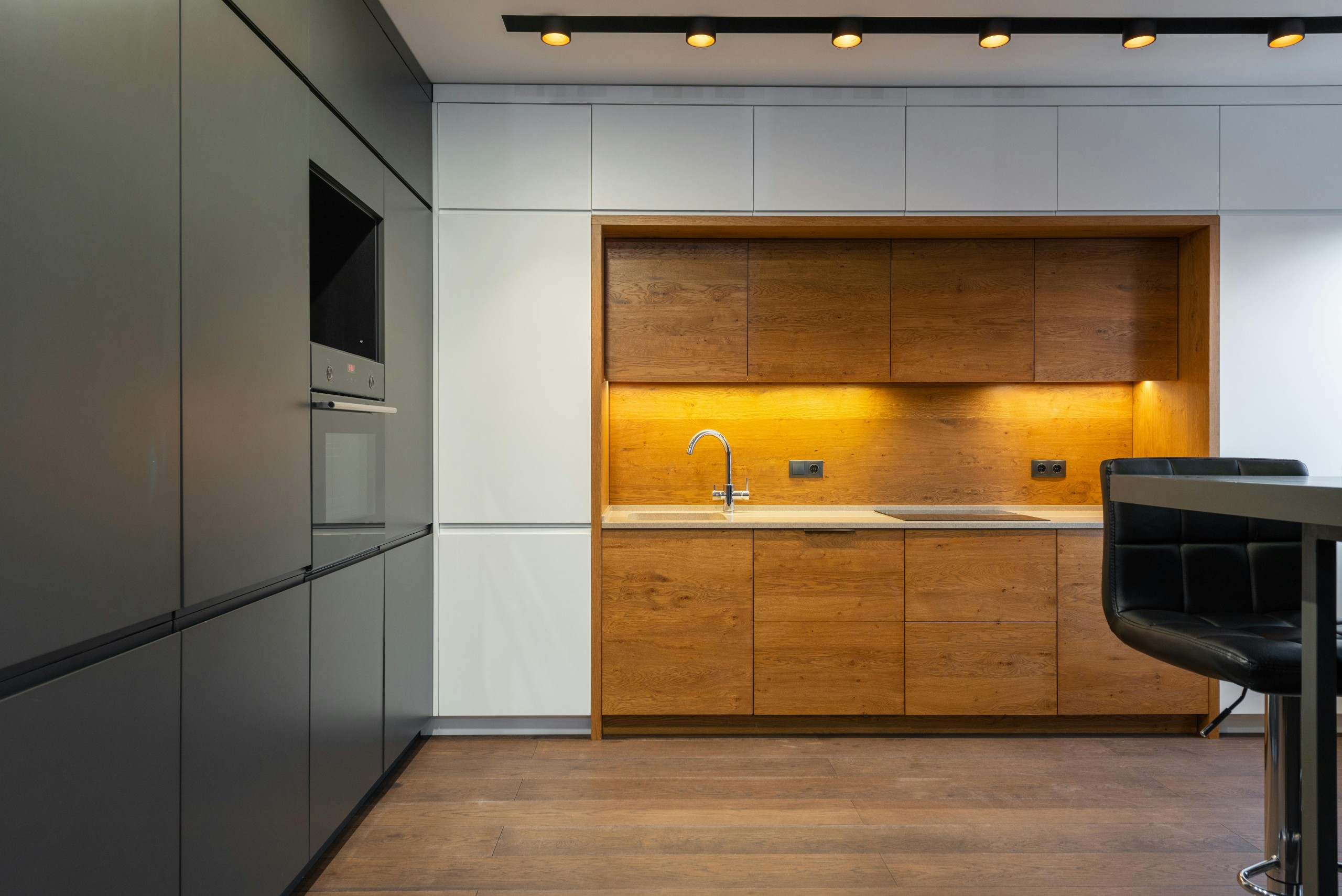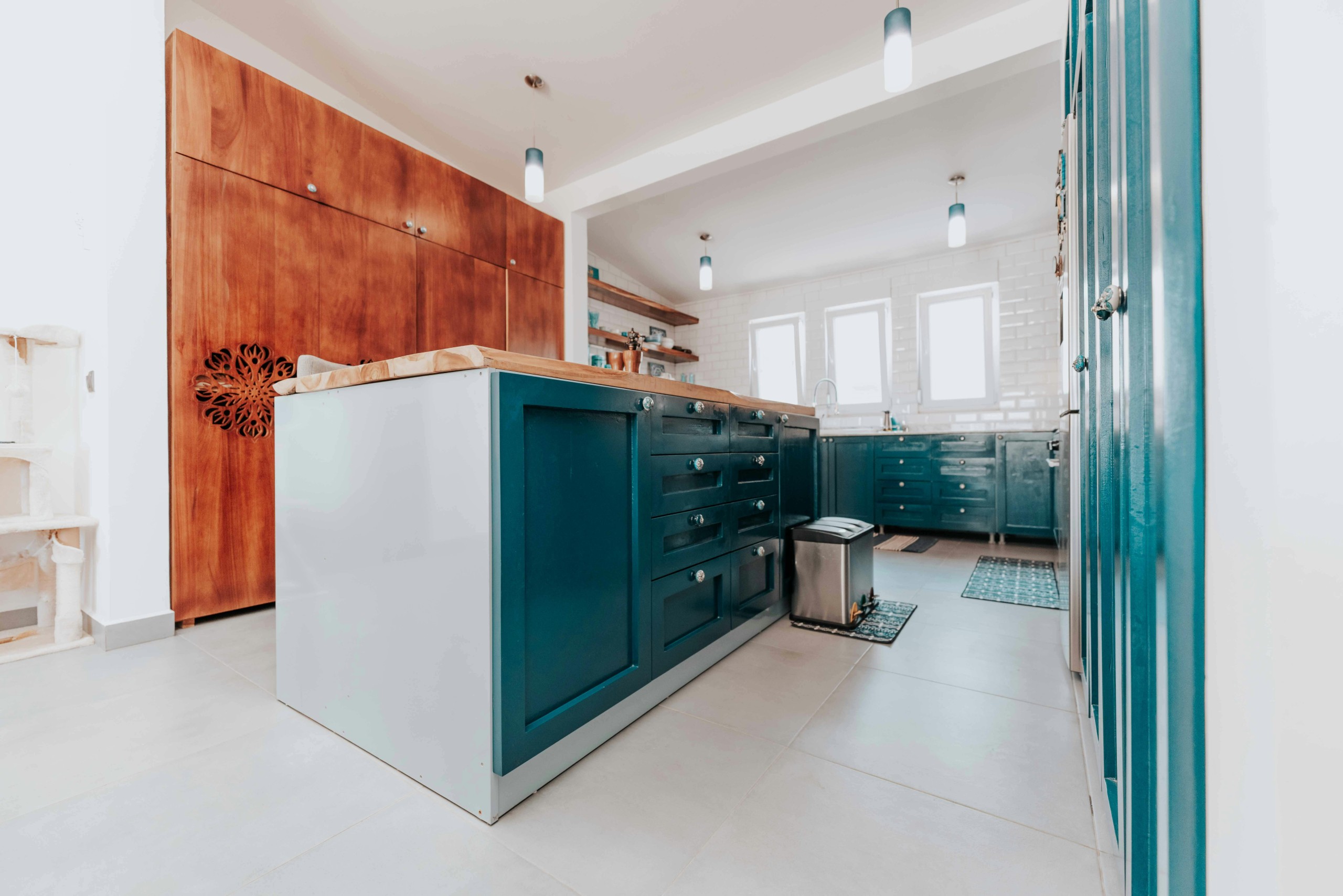Contemporary Kitchen Design: Sleek, Stylish, and Functional
Outline of the Article:
- Introduction
- Definition of contemporary kitchen design
- Why contemporary kitchens are popular
- Key Elements of Contemporary Kitchen Design
- Clean lines and minimalist aesthetics
- Neutral colour palettes with bold accents
- High-quality, durable materials
- Contemporary Kitchen Layout Ideas
- Open-plan kitchens
- L-shaped and U-shaped layouts
- Galley kitchens with integrated storage
- Contemporary Kitchen Materials and Finishes
- Cabinet materials and finishes
- Worktop options
- Flooring and backsplash materials
- Colour Schemes and Design Trends
- Monochrome and two-tone colour schemes
- Warm neutrals with dark accents
- Earthy greens and soft blues
- Lighting and Ambiance
- Layered lighting strategies
- Pendant lighting and LED strips
- Task and ambient lighting
- Modern Appliances and Smart Technology
- Built-in ovens and fridges
- Smart kitchen gadgets
- Voice-controlled and touchless features
- Creative Storage Solutions
- Soft-close drawers and pull-out shelves
- Vertical storage options
- Hidden compartments and appliance garages
- Statement Features in Contemporary Kitchens
- Bold kitchen islands
- Open shelving
- Contrasting textures and mixed materials
- Eco-Friendly and Sustainable Choices
- Recycled materials for worktops and cabinets
- Energy-efficient appliances
- Water-saving taps and fixtures
- Common Mistakes to Avoid
- Overcrowding the space
- Poor lighting choices
- Not planning enough storage
- Costs and Budget Considerations
- Average costs for contemporary kitchen design
- Where to splurge and where to save
- Long-term value considerations
- Conclusion
- Why contemporary kitchen design is timeless
- How to blend functionality with style
- FAQs
- What is the difference between contemporary and modern kitchen design?
- Are handleless cabinets still popular in contemporary kitchens?
- What are the most popular materials for contemporary worktops?
- How can I make a small kitchen feel more contemporary?
- What’s the best lighting for a contemporary kitchen?
Contemporary Kitchen Design: Sleek, Stylish, and Functional
Introduction
Contemporary kitchen design is all about clean lines, minimalist aesthetics, and high functionality. Unlike traditional kitchens, which often focus on decorative details, contemporary kitchens embrace simplicity, efficiency, and a seamless look.
In recent years, contemporary kitchen design has become one of the most popular styles due to its ability to combine style with practicality. The focus is on creating a space that feels open and uncluttered while maintaining a warm and inviting atmosphere.
Whether you’re planning a full kitchen remodel or just updating your space, understanding the key elements of contemporary design will help you create a kitchen that looks fresh, modern, and timeless.
Key Elements of Contemporary Kitchen Design
Contemporary kitchens are defined by a few essential design features:
✔️ Clean Lines – Flat-panel cabinets, streamlined worktops, and handleless designs.
✔️ Minimalist Aesthetics – Fewer decorative elements, focusing on simple and functional design.
✔️ Open Spaces – Open-plan layouts and fewer visual barriers.
✔️ High-Quality Materials – Stone, wood, and metal finishes for a sleek but durable look.
✔️ Neutral Colours with Bold Accents – White, grey, and beige paired with deep greens or navy blue.
✔️ Smart Storage Solutions – Hidden storage, pull-out shelves, and vertical cabinetry.
Contemporary Kitchen Layout Ideas
- Open-Plan Kitchens
- Open-plan kitchens integrate with the living or dining space, creating a seamless flow between rooms.
- Kitchen islands often serve as a focal point and provide additional seating and storage.
Best for: Social and family-focused homes.
- L-Shaped Kitchens
- Ideal for smaller or medium-sized spaces.
- Efficient use of corner areas with room for extra cabinetry and worktops.
Best for: Maximising space without overcrowding.
- U-Shaped Kitchens
- Provides a well-defined cooking area.
- Offers plenty of storage and worktop space.
- Easy to separate the cooking zone from the dining or living area.
Best for: Homes with larger kitchens.
- Galley Kitchens
- Efficient and functional layout with two parallel counters.
- Ideal for small spaces or narrow rooms.
- Easy to create a smooth flow between workstations.
Best for: Compact kitchens.
Contemporary Kitchen Materials and Finishes
✅ Cabinet Materials:
- High-gloss lacquer for a sleek and reflective finish.
- Matte finishes for a softer, modern look.
- Natural wood veneers to add warmth.
✅ Worktop Options:
- Quartz – Durable and low maintenance.
- Marble – Luxurious but requires sealing.
- Concrete – Modern and industrial but prone to staining.
✅ Flooring and Backsplashes:
- Large-format tiles for a seamless look.
- Herringbone wood floors for texture and warmth.
- Glass and subway tile backsplashes for easy cleaning.
Colour Schemes and Design Trends
1. Monochrome and Two-Tone Kitchens
- White and black combinations are timeless.
- Adding wooden elements brings warmth.
2. Warm Neutrals
- Beige, taupe, and cream tones for a calming effect.
- Blending with metallic accents like gold or brass.
3. Earthy Tones
- Deep greens, navy blues, and rich browns.
- Contrasted with lighter cabinetry and worktops.
Lighting and Ambiance
Layered Lighting: Combine task, ambient, and accent lighting for depth and warmth.
Pendant Lighting: Install over islands or dining areas for a statement look.
Under-Cabinet Lighting: Ideal for task lighting and adding warmth to the space.
Modern Appliances and Smart Technology
Smart Fridges: Track inventory and suggest recipes.
Induction Cooktops: Sleek and fast heating.
Voice-Controlled Systems: Integrate with Alexa or Google Home.
Creative Storage Solutions
✔️ Pull-Out Drawers: Ideal for pots and pans.
✔️ Hidden Appliance Garages: Keeps small appliances out of sight.
✔️ Vertical Storage: Utilise wall space for open shelves or tall cabinets.
Statement Features in Contemporary Kitchens
- Kitchen Islands: A focal point for both cooking and socialising.
- Mixed Materials: Wood, stone, and metal for contrast and texture.
- Floating Shelves: Keeps the space open while adding storage.
Eco-Friendly and Sustainable Choices
♻️ Recycled Materials: Countertops made from recycled glass or concrete.
♻️ Water-Saving Fixtures: Install taps with flow restrictors.
♻️ Energy-Efficient Appliances: Use less power and lower utility bills.
Common Mistakes to Avoid
Too Much Clutter: Keep surfaces clear and storage hidden.
Poor Lighting: Ensure all workstations are well-lit.
Ignoring Storage: Plan for enough storage to avoid clutter.
Conclusion
Contemporary kitchen design combines style, functionality, and innovation. With clean lines, high-quality materials, and smart technology, contemporary kitchens offer a perfect blend of modern living and practical design. Whether you prefer an open-plan layout or a sleek galley kitchen, the key to success is creating a space that reflects your lifestyle while maintaining a clean and modern aesthetic.
FAQs
- What is the difference between contemporary and modern kitchen design?
Contemporary kitchens reflect current trends, while modern kitchens focus on mid-century minimalism. - Are handleless cabinets still popular?
Yes, handleless cabinets remain a key feature of contemporary kitchens. - What are the most popular materials for worktops?
Quartz and marble are the most popular due to their durability and style.









